Posted 2011/1/25
Peking opera
Peking opera of China is a national treasure, which dates back to the year 1790. That year four local opera troupes of Anhui Province came to Beijing on a performance tour on the order of the imperial court. The tour was a hit and the troupes stayed. The artists absorbed the tunes of the Hubei local opera and drew on the best of Kun Qu, Qin Qiang and Bang Zi and other local operas.



With a history of over 200 years, Beijing Opera, which originated in Beijing, is the operatic form commanding the biggest following. It combines acting, dialogue, singing, music, dancing and acrobatics, and its roles can be classified in four categories: sheng, dan, jing and chou. In acting and acrobatics, different roles follow different patterns, all rather exaggerated, suggestive and symbolic. The actions of opening a door, going up the stairs, rowing a boat or climbing a hill, for instance, are done purely through the mime-like movements of the actors without the help of props.
The costumes in Peking opera are graceful, magnificent, elegant and brilliant, most of which are made in handicraft embroidery. As the traditional Chinese pattern is adopted, the costumes are of a high aesthetic value.
Since Mei Lanfang, the grand master of Peking opera, visited Japan in 1919, Peking opera has become more and more popular with people all over the world, and it has made an excellent contribution to cultural exchange between China and the West, to friendly association and to improvement of solidarity.
Peking Opera house of Beijing has been invited to perform in U.S.A., England, France, Germany, Italy (three times), Australia, Japan (four times), Brazil, Turkey, Singapore, South Korea and Hongkong (five times). The performances have made an outstanding contribution to Sino-foreign cultural exchange and to the promotion of friendly association of peoples in the world, and were highly appreciated by foreign audiences.
Peking Opera house of Beijing is willing to participate in activities of international cultural exchange and of commercial performances and sincerely hopes that friends in various countries will make contacts with us about cultural exchange and performances.

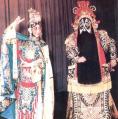

Facial Makeup’s Represent Different Characters
For the painted role, the different colors of the faces represent different characters and personality. Yellow and white represent cunning, red stands for uprightness and loyalty, black means valor and wisdom, blue and green indicate the vigorous and enterprising character of rebellious heroes and gold and silver represent mystic or super-natural power.
A plastic art peculiar to the Chinese stage, the facial makeups are various designs of lines and colored patches painted on the faces of certain operatic characters. They follow traditionally fixed patterns for specific types to highlight the disposition and quality in the personages so that the audience may immediately know whether they are heroes or villains, whether they are kind or treacherous and wicked. The following describes briefly the major categories of facial makeups: 
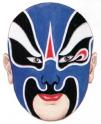
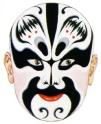

All the above facial makeups belong to a category of characters collectively called Jing--all males with pronounced personal traits.
For the clowns of traditional drama, there is a special makeup
The facial makeups date a long time back to the Song (960-1279) and Yuan (1271-1368) dynasties at least. Simple patterns of painted faces are found in tomb murals of that age. During the Ming Dynasty (1368-1644), improvements were made in the skills of drawing and in preparing the paints, leading to the whole set of colorful facial patterns that we see in today's Peking Opera.
The repertoire of Peking opera is mainly engaged in fairy tales of preceding dynasties, important historical events, emperors, ministers and generals, geniuses and great beauties, from the ancient times to Yao, Shun, Yu, the Spring and Autumn Period, the Warring States Period and the dynasties of Qin, Han, Sui, Tang, Song, Yuan, Ming, Qing. The widely well-known repertoires are Drunken Beauty, The King Says Farewell to His Concubine, The Universe Summit, etc.
The music of Peking opera is that of the "plate and cavity style”. Its melody with harmonious rhythms is graceful and pleasing to the ears. The melody may be classified into two groups: "Xipi" and "erhong", guiding pattern, original pattern, slow pattern, quick pattern, desultory pattern being their chief patterns.
The performance is accompanied by a tune played on wind instruments, percussion instruments and stringed instruments, the chief musical instruments being jinghu (a two-stringed bowed instrument with a high register), yueqin (a four-stringed plucked instrument with a full-moon-shaped sound box), Sanxian (a three-stringed plucked instrument), suona horn, flute drum, big-gong, cymbals, small-gong, etc.
Actually, "piao you" means Peking opera fans, "piao fang" means the place where fans meet to amuse themselves and "xia hai" means turning professional. When you come across with a small group of Peking opera fans singing in a street corner, that corner can be considered a "street piao fang".
"Sheng, Dan, Jing, Chou," for instance, are just the terms for four different types of roles. Every type has its telltale facial makeup and decoration.



Any role in these categories or sub-categories can be the leading role in a play. Except the second category, the other three categories are for male characters.
As for why the role categories take the names of Sheng, Dan, Jing and Chou, here is an explanation. It is said that they were chosen to mean the opposite. Sheng in Chinese may mean "strange" or "rare", but the chief male is a character of most seen. Dan, which means "morning", "masculine", is in controversy with the feminine nature of the characters. Jing means "clean". In fact, the paintings on face make the characters look like unclean but colorful. And Chou in Chinese sometime represents the animal "Cow", which, in some aspects, is slow and tardy. In contrast, Chou characters are usually active and quick.
Sheng -- Male Role:
Sheng has some sub-categories, including Senior, Junior, Acrobatic, Junior Acrobatic, Child, Red-face, Poor, Official, etc. These are classified according to the role's characteristics. Male roles are either civil or military. The actors themselves are mainly trained for three main parts: Senior Male Role or Lao Sheng, a middle-aged or old man who wears a beard, Junior Male Role or Xiao Sheng, a young man; and Acrobatic Male Role or Wu Sheng, a man of military tenor, especially skilled in acrobatics.
The red face Lao Sheng, or Hong Sheng has only two roles. One of such a role is Guan Gong who is regarded as the God of War. He is greatly revered and respected. Guan Gong is one of the heroes of the Chinese classical novel The Romance of the Three Kingdoms. The other Hong Sheng role is Zhao Kuang-Yin, the first Song Dynasty Emperor.
Dan -- Female Role:
The Dan or female role can be divided into six main parts which principally indicate character; Qing Yi, modest and virtuous; Hua dan, flirtatious; Gui Men Dan, a young unmarried girl; Dao Ma Dan, a stronger, more forceful character, usually a woman general; Wu Dan, the female acrobat; and Lao Dan, an old woman.
A Qing Yi actress portrays a lady of good and sympathetic character. Usually of a quiet, gentle disposition and graceful in her movements, she is the Chinese ideal of a beautiful woman. As a wife she is faithful, as a young girl a model of propriety. Her good breeding is shown by the graceful, flowing movements of her 'water sleeves'. The Qing Yi's costume is elegant, simple and of good quality, but not as vivid in color as that of the Hua Dan. Her singing is in a pure, high-pitched voice.
A Gui Men Dan is the young, unmarried girl, who in later life will develop into a Qing Yi or a Hua Dan; her immaturity is clearly shown in her naughty and slightly mischievous actions. She has not the confidence of the Hua Dan, although her schemes and plans are often just as successful.
A Dao Ma Dan plays the part of the female warrior. She is trained mainly for acting and singing and performs many skillful movements especially with the pheasant feathers in her headdress and her military weapons. She still retains feminine charm, however, and a very versatile actress is required for this role. Her parts, such as that of Mu Gui Ying, are of the heroines in Chinese history who were famed for their military prowess. A Dao Ma Dan's clothes can be very elaborate, as she wears the four pennants strapped to her back.
A Wu Dan is the female acrobatic role and the Wu Dan actress steps into or takes any female role that requires a high degree of acrobatics. She is not only a purely acrobat but demands a talented actress for a successful performance.
A Lao Dan is simply an old woman, but great skill is required for this specialized part. The Lao Dan actress cleverly portrays in her bent back and faltering but dignified movements. She is often seen carrying a staff. Unlike the other female roles, the Lao Dan wears no make-up and her costume is more subdued in color and design. Her voice tends to be slightly deeper, because the natural voice is used, not the forced high-pitched one used by other Dan roles.


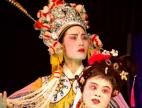
Jing -- Painted Face Male:
Chou -- The Comedy Role:
Mention must be made of the Monkey King who has a special place in the hearts of all who are interested in Chinese opera. Played by an exceptionally talented Wu Sheng actor, the Monkey King holds every minute of the audience's attention with the quick, agile movements of his lithe body, and his blinking eyes.


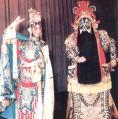
The Monkey King also has a troupe of monkeys who behave in the same manner, but all have their own characteristics--one is greedy, one naughty, one sleepy, etc.--and their skilful acrobatics and movements are a continual source of delight and object of affection for the audience.